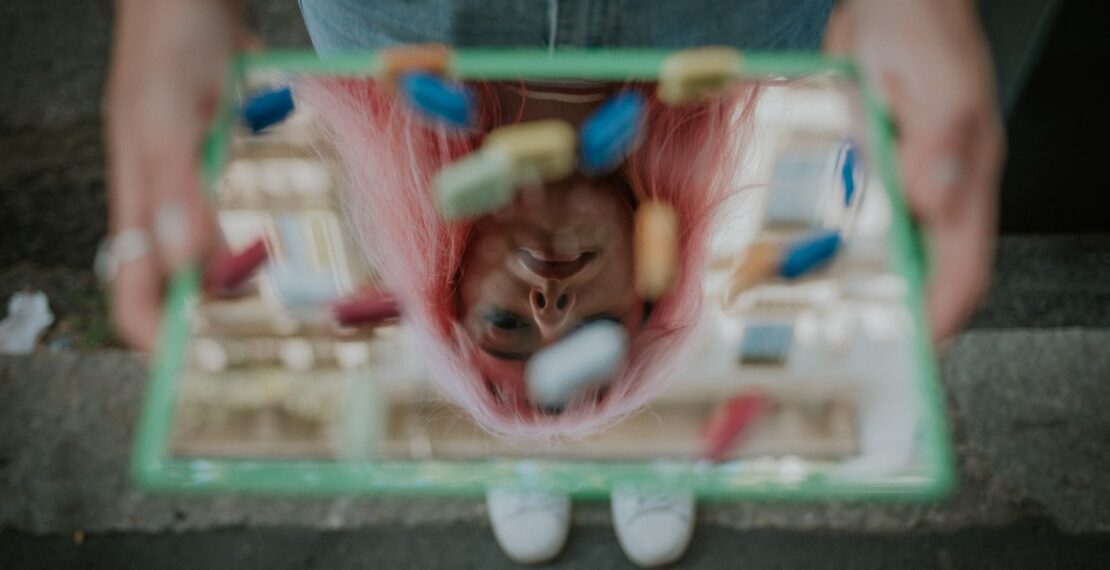Welcome to part one in a three-part series about Responsible Psychedelic Use.
Amid all the excitement and positivity as we crest the Third Wave of psychedelic medicines, a moment of quiet self-reflection may be in order. In the first of a new three-part series about the responsible use of these powerful tools for self-transformation, we discuss potential pitfalls for the unwary from using various medicines, from ketamine and kambo to the classic psychedelics.
Consider Eddie, an aspiring novelist grappling with writer’s block. He hasn’t written a word for months and, to make matters worse, his girlfriend has just left him.
Eddie feels washed up, a total failure. When an acquaintance proffers him a little white pill that he swears will help Eddie overcome all his creative and romantic difficulties, he is only too glad to give it a shot. What’s to lose?
Just four days after popping the pill—a new nootropic called NZT-48—Eddie has finished his novel in a whirlwind of inspiration. He feels great. For his next project, with his powers of reasoning and recall supercharged and his thoughts lightning fast, he dives into the stock market and quickly makes a fortune.
For a while it seems there is nothing Eddie can’t achieve. On NZT-48 he is confident, charismatic—irresistible.
But there’s a price. Inexplicable gaps open up in his memory. Without the drug, he suffers excruciating withdrawal effects and, as he soon discovers, other users are prepared to kill him to secure their own supply.
As you may have guessed, this is pure fiction: Eddie is the protagonist of the 2011 movie Limitless. Real life isn’t quite so melodramatic, but the film does illustrate the seductive charm of “chemical fixes”—substances that we tell ourselves will resolve all our difficulties, while allowing us to find fulfilment, happiness, and be the best we can possibly be.
Shiny New Wonder Drugs
In a climate of increasing optimism about the benefits of psychedelic substances and their legalization, it is worth remembering that there is no quick fix for life, no magic chemical bullet for all our troubles. After all, there is so much more to a life well lived than chemistry.
And if the history of medicine teaches us anything, it is that, for every shiny new wonder drug, there are unintended consequences. Aspirin, anesthetics, antibiotics, antidepressants, opioids, benzodiazepines—it turns out all of them have significant downsides that cannot be swept under the carpet.
While these drugs have become important to Western medical treatments, using them in responsible and informed ways is paramount. The sharper the tool, the more care must be exercised in its use, and psychedelics—with their extraordinary potential for transforming lives—are no exception to this rule.
In the past few years, the classic psychedelics (which bind to the 5-HT2A serotonin receptor), such as LSD, DMT, and psilocybin, have shown tremendous promise in combination with psychotherapy for treating depression, end-of-life anxiety, smoking addiction, post-traumatic stress disorder (PTSD) and other mental health issues. They can also help unlock a person’s creative abilities and enhance their sense of connection to nature and to other people.
Research at Johns Hopkins Medical School and elsewhere suggests that psychedelics’ clinical benefits are partly dependent on the spiritual breakthroughs afforded by doses high enough to trigger ego dissolution. While the classic psychedelics are non-toxic and non-addictive, they provoke psychological challenges at such high doses, and these can spiral dangerously in uncontrolled, non-clinical settings.

One Of Life’s Most Challenging Experiences
Temporary emotional turbulence is normal and can be integral to the experience. A study in the UK, for example, found that around a third of people who take psilocybin mushrooms experience paranoia and anxiety at some point during their journey.
An online survey that asked 1,993 recreational users about their worst “bad trip” on magic mushrooms found that 39% rated it as one of the most challenging experiences of their lifetime. Among those who had the experience more than a year previously, 7.6% said it led them to seek treatment for psychological problems. The researchers report that there were three cases of enduring psychosis, and three attempted suicides.
Crucially, however, the survey also suggested that the more challenging the experience, the more likely were subsequent improvements in wellbeing. Overall, 84% of respondents said they benefited despite the discomfort of the journey.
The researchers say the long-term psychological risks from classic psychedelics are “extremely low” in controlled, clinical settings in which people are prepped about what to expect and supported during their journey. As we will explore further in the next article in this series, responsible use outside the clinic entails close attention to “set and setting”, which means cultivating an appropriate mindset and preparing a safe, calm, and supportive environment in advance.
It is also worth noting that participants in clinical trials of psilocybin, LSD, and DMT are invariably screened to exclude people with conditions such as schizophrenia and bipolar disorder, which increase their risk of psychosis. Psychedelic retreat centers also screen applicants for these conditions, though the process depends on people giving honest answers to questions about their medical history.
A Heady Cocktail Of Neurotransmitters
These cautions apply in a range of circumstances. If you are considering an ayahuasca retreat, for example, understand that the risks of psychosis are compounded because the infusion not only contains DMT but also plant-derived monoamine oxidase inhibitors (MAOIs) and a selective serotonin reuptake inhibitor (SSRI).
The MAOIs prevent the breakdown of DMT, but they also inhibit the breakdown of serotonin, dopamine, and noradrenaline, ramping up levels of these neurotransmitters in the body. The SSRI boosts serotonin levels still further, which could lead to dangerously high levels, known as “serotonin syndrome”. Severe serotonin syndrome can cause seizures, irregular heartbeat, and unconsciousness, among other symptoms, and may be fatal.
This is a heady cocktail for anyone, let alone someone who is vulnerable to psychosis, or who may already have high neurotransmitter levels as a result of taking an SSRI or MAOI antidepressant. For the same reason, reputable ayahuasca retreat centers ban the use of caffeine, alcohol, and all recreational drugs. They also advise a “washout period” without prescription and non-prescription psychoactive drugs starting several weeks before the retreat starts.
Nicotine, which also raises neurotransmitter levels, remains a contentious issue because traditional ceremonies may incorporate it in the form of high-nicotine “wild tobacco” or rapé.
It’s also worth remembering that your retreat may involve several ceremonies within a short space of time, causing a steady buildup of neurotransmitter levels in your body. Sleep loss as a result of this stimulant effect and successive nighttime ceremonies will, in itself, raise the risk of a manic episode for vulnerable individuals.
While a review of case reports of psychotic episodes associated with DMT or ayahuasca concluded that such episodes are rare in both ritual and recreational settings, the authors advise: “Individuals with a personal or family history of any psychotic illness or nonpsychotic mania should avoid hallucinogen intake.”

Fake Shamans And Dodgy Brews
Another essential ingredient for the responsible use of ayahuasca is an experienced, trustworthy shaman. Among the hidden hazards of ayahuasca tourism are unscrupulous individuals who add other hallucinogens, such as scopolamine, to the tea to create more impressive hallucinations.
Similarly, those who want to try the frog venom kambo should be wary of fake shamans and, indeed, fake kambo. Another crucial issue to consider is animal welfare. The frog secretes the venom from its skin when under threat from predators, and so the only way to “harvest” the substance for human use is to stress it in some way. Whether this can be done without harming it is an open question.
The venom—a potent purgative that is claimed to have cleansing, detoxifying effects—is applied in a healing ritual through burns in the skin. The peptides in the venom provoke transient symptoms including nausea, vomiting, diarrhea, and facial swelling.
There have been no clinical trials of kambo, but users report relief from depression, chronic pain, and addictions.
The authors of one scientific literature review found only a handful of reports of adverse events. Some were serious, however, and there were four deaths. But the scientists attributed many of the adverse events to excessive fluids drunk before or after the ceremony. They conclude that kambo is inadvisable for anyone with psychosis, cardiovascular disease, low blood pressure, or who is pregnant or breastfeeding. More controversially, they claim anyone with severe depression, anxiety, or bipolar disorder should avoid it.

Dependence, Withdrawal, and Addiction
Bear in mind that frequent use of kambo may also lead to dependence or mild addiction. Drug specialists told Vice that this may occur because the venom contains peptides that bind to opioid receptors.
People can become psychologically reliant on any substance that makes them feel good or that relieves suffering. Physical dependence occurs if their body develops tolerance to the substance (they need more of it to get the same effect) and experience withdrawal symptoms if they have to go without it. Over time this may lead to addiction, which is the point at which neural and biochemical changes in the brain begin to cause irrational behavior that can potentially harm both oneself and others.
It may come as a surprise that ketamine—which is showing promise as a treatment for addiction—can itself be addictive.
For people experiencing the agonies of severe, treatment-resistant depression, ketamine truly is a wonder drug. Combined with psychotherapy, it can bring blessed relief from depression and suicidal thoughts within 24 hours. But psychologists at the University of Texas at Arlington point out that symptom relief is temporary, necessitating repeated doses.
They report a striking overlap between the disruptions in the brain’s dopamine reward system seen in depression, and those seen in addiction. Ketamine is known to increase dopamine levels, which may partly underlie its remarkable antidepressant effects.
“Repeated use of ketamine during therapy for treatment-resistant depression has effects on the brain that are similar to other abused drugs and hence, in theory, may cause dependence and abuse,” says lead author Dr. Saurabh Kokane.
Crucially, for people who become dependent or addicted, long-term, heavy use of ketamine is associated with a wide range of physical and psychological problems, including kidney and bladder damage, memory loss, and delusional thinking.
A Case Of Drug Substitution?
The psychologists warn that people who take ketamine frequently and repeatedly, for whatever purpose, run the risk of developing tolerance and addiction. “As with any drug, repeated use lowers the therapeutic effects because of development of tolerance,” says Dr. Kokane.
Some medical professionals even go so far as to suggest that ketamine’s early promise as a treatment for addiction may be a case of drug substitution—like methadone for heroin.
Patients who can’t afford ketamine treatment in a clinic may turn to cheaper, less reliable sources of the drug. Needless to say, this introduces further dangers for the unwary, including increased potential for abuse. There are reports of fentanyl—a highly addictive opioid—being added to illicit ketamine in Australia and in the United States (specifically in New York City and in California).
Ketamine alone can cause an overdose, but ketamine adulterated with fentanyl greatly increases this risk.
Fentanyl testing strips are available and are among the strategies for more responsible psychedelic use that we share in the next article in this series.
Other essential strategies that we will discuss include:
- Strict dose control
- Pacing yourself
- Informing yourself
- Finding help from a guide or sitter
- Integrating the lessons
- Realistic expectations
Reports have reached Third Wave about people who believe they have found “the master key to the universe” in a particular substance. Like Eddie, the fictional protagonist of Limitless, they are convinced that, despite all the evidence to the contrary, they are not addicted, are not harming themselves and those around them, and that everything is OK.
We hope this series will help to bring the issue of responsible, healthy use of psychedelics and other powerful, healing plants and substances into sharper focus.
Psychedelics alone can’t heal you, but, used wisely, they can be a great tool for healing. If you’re interested in microdosing and want to do it with expert guidance rather than going it alone, sign up for our Microdosing Course. Using the latest research from cutting-edge scientists and doctors, we’ll help you develop a customized, step-by-step process to change habits, enhance creativity, and optimize performance.







